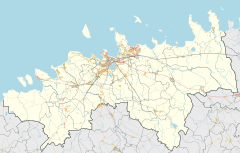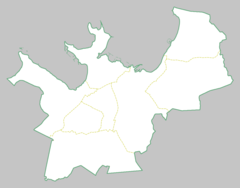You can help expand this article with text translated from the corresponding article in Estonian. (July 2023) Click [show] for important translation instructions.
|
Baltic Station (Estonian: Balti jaam) is the main railway station in Tallinn, Estonia, and the largest railway station in Estonia.[2] All trains in Estonia depart and terminate at this station.
Tallinn Baltic Station Balti jaam | |||||||
|---|---|---|---|---|---|---|---|
| railway terminus | |||||||
 | |||||||
| General information | |||||||
| Location | Toompuiestee 37 10133 Tallinn Estonia | ||||||
| Coordinates | 59°26′23.82″N 24°44′13.74″E / 59.4399500°N 24.7371500°E | ||||||
| Owned by | Go Group | ||||||
| Operated by | Go Group | ||||||
| Line(s) | Elron Tallinn-Tartu-Valga Elron Tallinn-Tartu-Koidula Elron Tallinn-Narva Elron Tallinn-Viljandi Elron Tallinn-Aegviidu Elron Tallinn-Turba/Paldiski | ||||||
| Platforms | 7 | ||||||
| Tracks | 12 | ||||||
| Train operators | Elron[1] | ||||||
| Connections | Bus 21 21B 41 41B 43 59 Tram 1 2 5 | ||||||
| Construction | |||||||
| Structure type | at-grade | ||||||
| Parking | No parking at the station. Spaces for stopping and loading. | ||||||
| Bicycle facilities | An outdoor bicycle parking lot next to the station. | ||||||
| Accessible | Yes | ||||||
| Other information | |||||||
| Fare zone | Zone 1 - Tallinn | ||||||
| History | |||||||
| Opened | 1870 | ||||||
| Rebuilt | 1960-1966 | ||||||
| Electrified | 1924 3 kV DC OHLE | ||||||
| |||||||
Balti jaam is located in central Tallinn, and is situated immediately northwest of the city's Old town (Estonian: Tallinna vanalinn). It stands close to a large market called the Baltic Station Market (Balti Jaama Turg).
The first station opened in 1870 when a railway line connecting Saint Petersburg with Paldiski via Tallinn was opened.[3] The station was completely reconstructed between 1960–1966, and in 2005, the station building was completely renewed.
History
editThe first railway station in Tallinn was built at the end of the 1860s as part of a 400 km (250 mi) long Saint Petersburg-Tallinn-Paldiski railway line. The first main building was completed in 1870. It was a two-storey building constructed from limestone with tower-like extrusions.
During the 1 December 1924 communist coup d'état attempt in Estonia, Karl Kark, the then Minister of Transportation[4] was assassinated by gunshot by pro-Soviet insurgents at the Tallinn Baltic Station.[5]
During World War II in 1941, the station building was set on fire by the Soviet Red Army. Shortly after the war, in 1945, the building was partially renovated. During 1960–1966, the station was completely reconstructed. Since the 1990s, the commuter trains 20x20m waiting pavilion has been used as a market. In 2005, the station building was completely renewed and Hotel Shnelli and the headquarters of Estonian Railways (Eesti Raudtee) were completed nearby.
Layout
editThe station has seven platforms, of which two are situated apart from the rest and have been serving the international Tallinn–Moscow and Tallinn–Saint Petersburg routes performed by GoRail, and Elron's long-distance route to Viljandi. Platforms closer to the station building are mostly used by the commuter trains or long-distance routes to Tartu or Narva.
Gallery
edit-
Old station (1910)
-
Exterior
-
Exterior
-
Platforms
-
Interior (2009)
-
Trolleybus (2015)
-
Locomotive L-2317
See also
editReferences
edit- ^ "Network and Stations". Elron. Retrieved 2 February 2023.
- ^ "Ohutud liikumisteed Tapa-Tallinn" (in Estonian). Eesti Raudtee. Archived from the original on 24 October 2021.
- ^ "About Estonian Railways - History". Eesti Raudtee. Archived from the original on 8 January 2007.
- ^ "1924 | Meie parlament ja aeg". meieparlamentjaaeg.nlib.ee. Retrieved 24 February 2021.
- ^ Arpo, Martin (1 December 2004). "Detsembrimäss 80 aastat tagasi". Postimees. Retrieved 18 November 2021.
- Tallinn Encyclopedia (part I), 2004. Page 30. ISBN 9985-70-168-2.
External links
edit| Preceding station | Elron | Following station | ||
|---|---|---|---|---|
| Terminus | Tallinn–Tartu–Valga | Kitseküla towards Valga
| ||
| Tallinn–Tartu–Koidula | Kitseküla towards Koidula
| |||
| Tallinn–Narva | Kitseküla towards Narva
| |||
| Tallinn–Aegviidu | Kitseküla towards Aegviidu
| |||
| Tallinn–Viljandi | Tallinn-Väike towards Viljandi
| |||
| Tallinn–Turba/Paldiski | Lilleküla | |||



